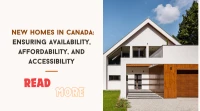New Homes in Canada: Ensuring Availability, Affordability, and Accessibility
New homes in Canada must be available, affordable, and accessible to meet the diverse needs of all Canadians, including the growing number of people with disabilities.
May 21, 2024
In the midst of Canada's ongoing housing crisis, discussions often center on the need to increase the availability and affordability of homes. However, an equally critical aspect is often overlooked: accessibility. As Canada’s population ages and the number of people with disabilities increases, the need for accessible housing becomes more pressing. Homes must be designed to meet the complex needs of all Canadians, including the one in five who identify as having one or more disabilities.
The Demographic Challenge
Approximately 22% of Canadians over the age of 15 identify as having a disability. This demographic is growing as the population ages, presenting a significant challenge for housing developers and policymakers. Accessible housing is crucial not only for those currently living with disabilities but also for the aging population who may develop mobility issues in the future.
Current Housing Initiatives
In response to these challenges, Canada has implemented several initiatives aimed at increasing the supply of affordable and accessible housing. The Liberal government's National Housing Strategy includes programs like the Rapid Housing Initiative and the Rental Construction Financing Initiative, both designed to boost the availability of affordable housing units.
In Calgary, for instance, city officials are considering blanket rezoning to allow for higher density housing, such as duplexes and row houses, which can help meet the growing demand for affordable homes. However, it is essential that these new homes are built with accessibility in mind from the outset, as retrofitting can be costly and sometimes impractical.
The Role of Accessibility
Accessibility features in housing include step-free entrances, wider doorways, and accessible bathrooms. These features are not only essential for people with disabilities but also beneficial for the elderly and those with temporary mobility issues. Ensuring that new homes are accessible from the start can save costs and provide a better quality of life for residents.
Dave Wilkes, president and CEO of the Building Industry and Land Development Association (BILD), emphasizes the importance of building homes that meet the diverse needs of Canadians. "As we build the 1.5 million homes needed to address the shortage of supply, we must recognize that the homes we build today will help form the backbone of our housing stock for many decades to come. Adding supply presents us with an opportunity to tackle two other critical issues, sustainability and accessibility, while meeting the needs of prospective home-buyers," Wilkes notes.
Combining Affordability and Accessibility
The challenge lies in combining affordability with accessibility. People with disabilities often face higher living costs, including medical expenses and reduced earning capacity. Affordable housing initiatives must, therefore, integrate accessibility features to ensure they are genuinely inclusive.
The Canadian government’s Housing Accelerator Fund aims to create 100,000 new middle-class homes by 2025, focusing on increasing supply in urban areas where demand is highest. However, it is vital that these homes are designed to be accessible to ensure they meet the needs of all Canadians.
Conclusion
Addressing Canada’s housing crisis requires a multifaceted approach that includes increasing the availability and affordability of homes. However, to create truly inclusive communities, accessibility must also be a priority. By integrating accessibility features into new housing developments and ensuring affordability, Canada can better meet the diverse needs of its population and create a more equitable housing market.
Ensuring that new homes are available, affordable, and accessible is not just about meeting immediate needs but about future-proofing our communities for generations to come. As Dave Wilkes of BILD highlights, making purposeful choices in our housing strategies can address the pressing needs of supply, affordability, accessibility, and sustainability all at once.
